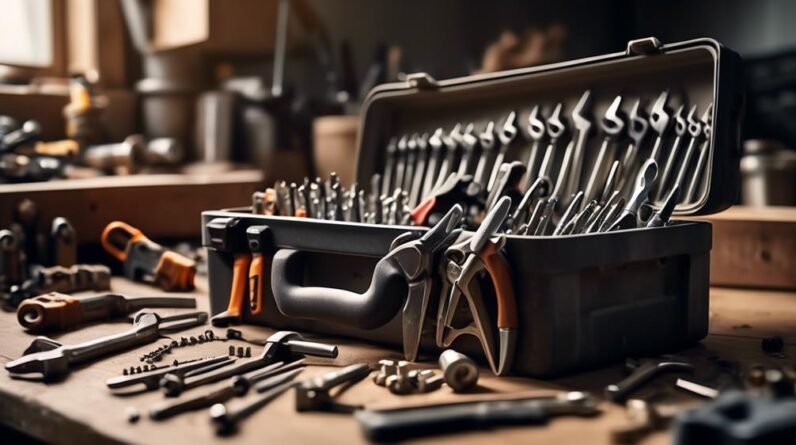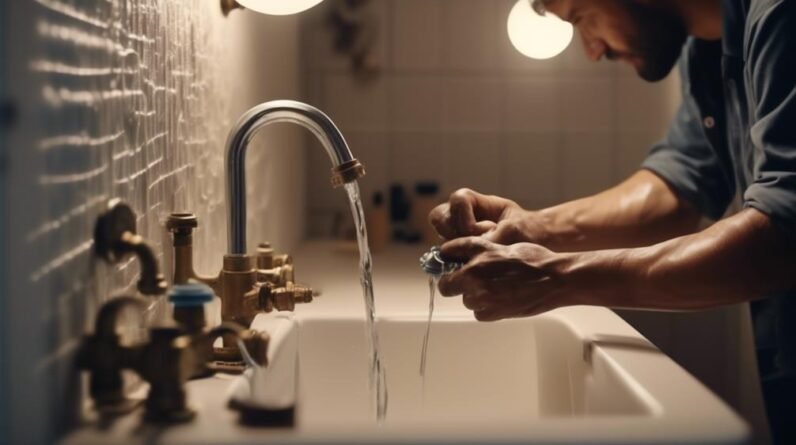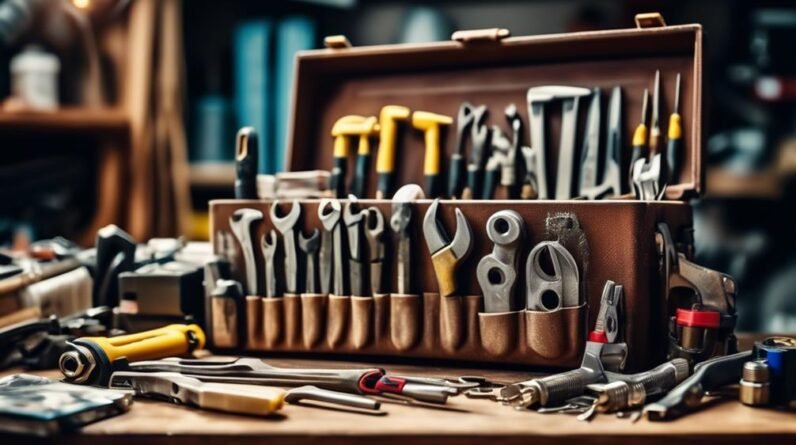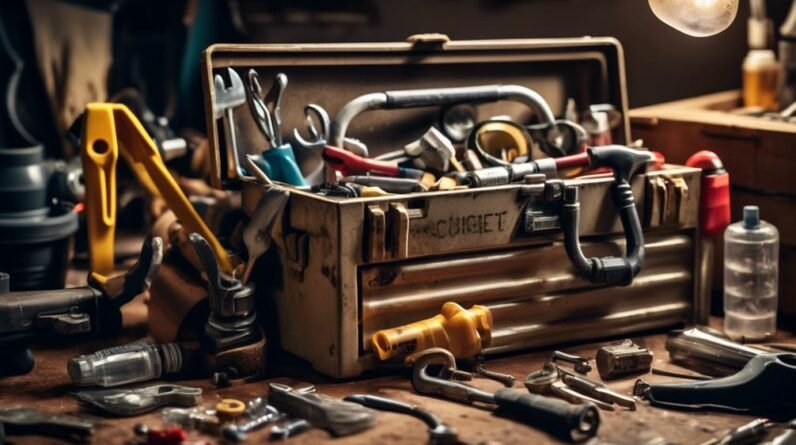
Are you tired of calling a professional every time something breaks in your home? Well, fear not! In the world of home repair, there are simple fixes that even beginners can handle. From fixing a leaky faucet to patching a hole in the wall, this beginner's guide will equip you with the knowledge and confidence to tackle these common household issues on your own. So, why wait for someone else to fix it when you can be the hero of your own home?
Key Takeaways
- Leaky faucets can be repaired by diagnosing the cause of the leak and gathering the necessary tools for the repair.
- Patching a hole in the wall requires cleaning the area, applying spackling compound, and achieving a seamless finish with sandpaper.
- Clogged drains can be repaired by removing visible debris, using a plunger or drain cleaner, and flushing with hot water.
- Replacing a broken light switch involves ensuring the power is turned off, disconnecting and reconnecting wires, and securing the new switch.
- Installing a new door handle requires measuring and drilling a new hole, attaching the latch and handles, and troubleshooting common issues.
Fixing a Leaky Faucet
To fix a leaky faucet, you'll need some basic tools and a little bit of patience. The first step is to diagnose the cause of the leak. Common causes include a worn-out washer, a loose valve stem, or a faulty cartridge. Once you have identified the cause, you can proceed with the necessary repairs.
Choosing the right tools for the job is crucial. You will need an adjustable wrench, pliers, a screwdriver, and a replacement part, depending on the cause of the leak. If it's a washer issue, you'll need to turn off the water supply, remove the handle, and replace the worn-out washer. If it's a loose valve stem, you'll need to tighten the packing nut or replace the packing material. For a faulty cartridge, you'll need to remove the handle, unscrew the cartridge, and install a new one.
Remember to turn off the water supply before starting any repairs. Take your time and follow the manufacturer's instructions or consult online tutorials for guidance. With the right tools and a little patience, you can fix that leaky faucet and save yourself from wasted water and a higher water bill.
Patching a Hole in the Wall
If you have a hole in your wall, don't worry – it can be easily patched with a few simple steps. Drywall repair is a common home repair task that you can tackle on your own. Here are some spackling techniques to help you patch up that hole seamlessly.
First, gather the necessary tools: a putty knife, sandpaper, a drywall patch, and spackling compound. Clean the area around the hole and remove any loose debris. Next, apply the spackling compound to the hole using the putty knife. Make sure to fill the hole completely and smooth out the surface.
Once the spackling compound is dry, use sandpaper to smooth it down until it is flush with the wall. This will ensure a seamless finish. You can then paint over the patched area to match the rest of the wall.
Repairing a Clogged Drain
Repairing a clogged drain is a common household task that can be easily accomplished with a few simple steps. Here's what you need to do:
- Identify the problem: Determine whether you're dealing with a clogged shower drain or a blocked kitchen sink. This will help you choose the appropriate method to unclog the drain.
- Remove any visible debris: Use a pair of gloves and a flashlight to check for any hair, food particles, or other debris that may be causing the clog. Remove it manually using your hands or a pair of tweezers.
- Try a plunger: For shower drains, a plunger can be an effective tool to clear the blockage. Make sure to cover the overflow drain with a wet cloth or tape to ensure proper suction. Plunge vigorously for a few minutes to dislodge the clog.
- Use a drain cleaner: For kitchen sinks, you can try using a commercial drain cleaner. Follow the instructions on the packaging carefully and make sure to wear protective gloves. Pour the cleaner down the drain and let it sit for the recommended amount of time before flushing with hot water.
Replacing a Broken Light Switch
When replacing a broken light switch, follow these simple steps for a quick and easy fix. First, ensure that the power to the switch is turned off by flipping the circuit breaker that controls the switch. Use a voltage tester to double-check that there is no electrical current flowing to the switch. Once you have confirmed that the power is off, remove the switch cover plate by unscrewing the screws that hold it in place. Next, unscrew the screws that secure the switch to the electrical box. Carefully pull the switch out of the box, making sure not to touch any exposed wires. Disconnect the wires from the old switch, noting their positions. Connect the wires to the corresponding terminals on the new switch, using wire nuts if necessary. Finally, secure the new switch to the electrical box and replace the switch cover plate. With these simple steps, you can easily replace a broken light switch and restore functionality to your lighting system. Remember to always prioritize safety when working with electrical outlets and troubleshooting electrical wiring.
Installing a New Door Handle
Now that you have successfully replaced a broken light switch, let's move on to installing a new door handle. Installing a new door handle is a relatively simple task that can instantly update the look of your doors. Here are some steps to guide you through the process:
- Measure and mark: Start by measuring the distance between the center of the existing hole and the edge of the door. Use these measurements to mark the new hole for the door handle.
- Drill the hole: Use a hole saw or spade bit to drill the new hole for the door handle.
- Attach the latch: Insert the latch into the edge of the door and secure it in place with screws provided.
- Install the door handle: Place the exterior and interior handles on either side of the door and align them with the latch. Insert the connecting screws and tighten them with a screwdriver.
Troubleshooting common door handle issues:
- Loose handles: Tighten the screws holding the handle in place.
- Sticking latch: Lubricate the latch with a silicone-based lubricant.
- Misaligned strike plate: Adjust the strike plate to align with the latch.
Frequently Asked Questions
How Do I Fix a Leaky Showerhead?
To fix a leaky showerhead, start by turning off the water supply. Then, unscrew the showerhead and check for any loose or damaged parts. Replace any faulty parts and reassemble the showerhead. Turn the water supply back on and test for leaks.
What Should I Do if There Is a Crack in the Wall?
If there's a crack in the wall, start by assessing the severity. For small cracks, apply a patching compound and smooth it out. To prevent future cracks, address any underlying issues like foundation problems or moisture infiltration.
How Can I Unclog a Toilet?
To unclog a toilet, start by using a plunger. If that doesn't work, try using a toilet auger. Common causes of clogs include too much toilet paper or foreign objects.
What Steps Should I Follow to Replace a Faulty Electrical Outlet?
To replace a faulty electrical outlet, start by turning off the power. Then, remove the outlet cover and unscrew the old outlet. Disconnect the wires and attach them to the new outlet. Finally, screw it back in and test it.
Can You Provide Instructions on Installing a New Lock on a Door?
To install a new lock on a door, start by choosing the right lock for your home. Then, follow the manufacturer's instructions for installation. Make sure to securely fasten the lock to ensure maximum security.
Conclusion
In conclusion, by following this beginner's guide to home repair, you can easily tackle common household issues. Fixing a leaky faucet, patching a hole in the wall, repairing a clogged drain, replacing a broken light switch, and installing a new door handle are all simple fixes that can save you time and money. With a little effort and the right tools, you can become a confident DIY homeowner and keep your home in tip-top shape.







